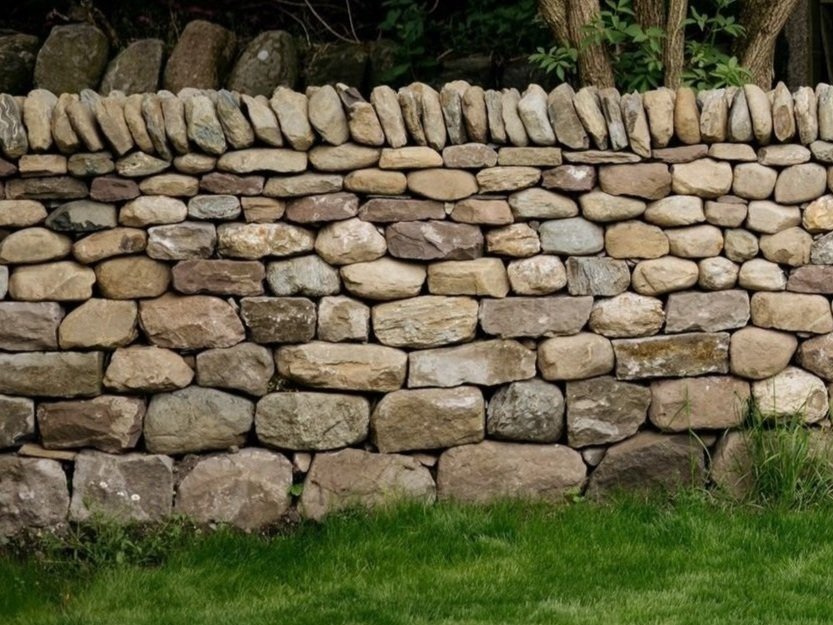Drystone A to Z
ALSTON STONE
Quarried in Cumbria ‘Alston Stone’ is a sandstone famed for its strength. Hugely popular stone within the drystone industry and for good reason.
BARS AND STRING
Bars are placed at intervals along the structure and then lines are strung between them. We use these as a visual aid when building to ensure correct batter and line of the wall.
BATTER
The slope of the wall. Drystone walls are built on a slight A-line which can change based on horizontal and vertical dimensions. The bottom of the wall is much wider than the top.
CHEEKEND
Type of drystone feature that you use to end a section of wall.
COPE STONES
Cope stones are the stones places at the very top of the wall, used to protect the internal structure. Copes can be applied in various styles, the image shows ‘double copes’
COURSE
One layer of stones in the wall.
COURSED
A wall with clear uniform courses or ‘layers’.
COVERBAND/COVERS
A layer of throughs placed on top of a wall to provide greater structure as well as a base for the copes.
DOUBLE COPES
Where two, upright cope stones are used to span the width of the wall. Placed in an interlocking fashion to ensure stability
DRYSTONE WALL
A stone wall built without mortar.
In Scotland known as a Drystane Dyke.
FACE/FACE STONE
Although stones have many ‘faces’, we use the term ‘face stone’ to describe the side of the stone that is visible in the wall. There are certain specifications that dictate which ‘face’ of a stone should be visible.
FANK
A drystone pen that encloses sheep. They are usually built in square, rectangular or circular shapes with one or two gates.
FEATURE STONE
A large stone, usually much bigger than all others in a wall, used as a feature within the drystone structure. This aesthetic choice actually comes from necessity where large, immovable boulders often had to be built around in agricultural walls.
FIELDSTONE
Stone that has been cleared from fields. Usually a wide mix of stone types and different in each area, depending on the geology of that place. Fieldstone produces colourful and visually interesting walls, lends itself well to most building styles.
FLAT COPES
Single cope stone used to span the width of the wall. Laid flat instead of upright.
FOUNDATIONS
The first course of a wall. Traditionally where the biggest stones are placed.
GAPPING
A term describing the process of repairing fallen sections of existing walls.
HEARTING
Small stones that sit between the two sides of the wall ‘locking’ them in place. Hearting (or packing) is one of the most essential parts of a drystone wall and every piece is placed by hand and with intention.
JOIN/JOINT
The small gap between two adjacent stones. Joins should always be fully crossed by stones on the upper courses, avoiding structural weaknesses like ‘running joints’ and ‘zippers’. There are some slight exceptions to this rule when building in ‘semi-coursed’ and ‘random’ styles.
JUMPER
A stone that rises through more than one course of the wall. Commonly found in semi-coursed or ‘random’ built walls.
LENGTH-IN
‘Strength in length’. Putting stones length into the wall. This means there is more of the stone in the wall than along the wall. It also helps ensure good internal contact and is one of the fundamental principles of drystone walling.
PINS
Small wedge shaped stoned that are placed from the inside or outside of the wall to fill any gaps between stones. These are important both structurally and aesthetically.
RANDOM
A more extreme version of ‘semi-coursing’ where, of the three styles, the courses of the wall are least obvious.
RETAINING BED
A small retaining wall to be back filled with soil and planted up with flowers and plants.
RETAINING WALL
A wall built across a bank or slope to keep the soil from slipping. Usually built as deep as it is tall so a one metre tall retainer will extend one metre deep into the bank behind it.. A large part of the depth is made up of tightly packed stones.
SEMI-COURSED
When the courses of wall are less obvious and are broken up with stones that ‘jump’ between courses.
SINGLE COPES
A single, upright cope stone is used to span the width of the wall.
SNECKS
Small stones used to fill gaps between larger, irregular stone shapes or to bridge gaps in stone height. Often stacked on top of one another.
SHIMS
Thin stones that are stacked on or under other stones to make up a height difference.
STELL
A drystone structure that is the permanent equivalent of a wind break and are used to shelter sheep. They are found in many shapes, ‘C’, ‘U’, ‘X’ or just straight lines. Above is a stell-inspired seating area in a client’s garden.
STONE PILE
Stone that is pulled from fields during ploughing and preparation and then dumped in piles. We then re-purpose this stone into walls.
STRIPPING OUT
The process of taking down a section of existing wall, usually for repairs.
THROUGH STONES
Stones that sit across the width of the wall at around knee height and they sort of bind the wall together. Also, as the wall settles the idea is that they will help distribute any movement evenly. All round great (if not essential) for structural integrity and longevity.
WALL TREASURE
Items (usually of historical interest) found when ‘stripping out’ a wall. These could be old bottles, tools etc.
WHINSTONE
Term used for dark, very hard and dense stone. The actual stone type can vary but what these stone types have in common is that they are hard to work, shape and lift.


































